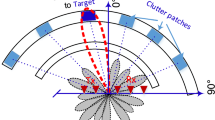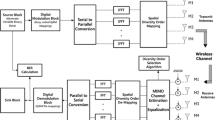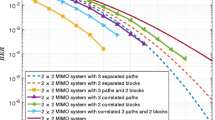Abstract
The time–space receive transformation (TSRT) is proposed to increased the achievable rate of the time–space multiple-input-multiple-output (MIMO) system (where the signals received at different time instants and spatial spots are jointly processed) with faster-than-Nyquist (FTN) signaling (where the symbol rate is higher than the Nyquist rate) in the frequency-selective fading channel. It is shown that for the TSRT base MIMO system with FTN signaling, the interference from other blocks can be ineffective so that its achievable rate increases with the ratio of the symbol rate to the Nyquist rate and can reach the maximal information rate of the time–space MIMO system. It is also shown that with FTN signaling, the achievable rate of the TSRT base MIMO system is larger than that of the trailing-zeros based MIMO system and the OFDM based MIMO system, and the ratio of the symbol rate to the Nyquist rate increases this advantage.


Similar content being viewed by others
References
Anderson JB, Rusek F & O¨wall V, 2013 ‘‘Faster-than-Nyquist signaling,’’ Proceedings of the IEEE, 101, 8, 1817–1830
Fan, J, Guo, S, Zhou, X, Ren, Y, Li, GY, & Chen, X (2017) Faster-than-Nyquist signaling: An overview. IEEE Access, 5, 1925–1940.
Ganji, M, Zou, X, & Jafarkhani, H (2020) On the capacity of faster than Nyquist signaling. IEEE Communications Letters, 24(6), 1197–1201.
Gesbert, D, Shafi, M, Shiu, DS, Smith, PJ, & Naguib, A (2003) From theory to practice: An overview of MIMO space–time coded wireless systems. IEEE Journal on Selected Areas in Communications, 21(3), 281–302.
Grokop, LH, & Tse, DNC (2009) Diversity–multiplexing tradeoff in ISI channels. IEEE Transactions on Information Theory, 55(1), 109–135.
Jiang, Y, Varanasi, MK, & Li, J (2011) Performance analysis of ZF and MMSE equalizers for MIMO systems: an in-depth study of the high SNR regime. IEEE Transactions on Information Theory, 57(4), 2008–2026.
Jindal, N, & Goldsmith, A (2005) Dirty-paper coding versus TDMA for MIMO broadcast channels. IEEE Transactions on Information Theory, 51(5), 1783–1794.
Kim YJD & Feng Y, 2020 “Capacity of multicarrier faster-than-Nyquist signaling,” in Proceedings 2020 IEEE International Symposium on Information Theory.
McGuire M, 2016 A Dimopoulos & M Sima, “Faster-than-Nyquist single-carrier MIMO signaling,” in Proceedings 2016 IEEE Globecom Workshops.
Rusek, F, & Anderson, JB (2009) ‘Constrained capacities for faster-than-Nyquist signaling.’ IEEE Transactions on Information Theory, 55(2), 764–775.
Wang, JT (2014). Decorrelation based receive transformation for MIMO system under multi-user co-channel interference. IEEE Wireless Communications Letters, 3(3), 305–308.
Wang, JT (2018). Interference-free criterion for interference-unaware receive transform in MIMO co-channel interference. IEEE Wireless Communications Letters, 7(2), 210–213.
Wang, BI, & Zhang, FZ (1992). Some inequalities for the eigenvalues of the product of positive semidefinite Hermitian matrices. Linear Algebra and its Applications, 160, 113–118.
Xiang, W, & Pietrobon, SS (2003). On the capacity and normalization of ISI channels. IEEE Transactions on Information Theory, 49(9), 2263–2268.
Yuhas M, Feng Y & Bajcsy J, 2015 “On the capacity of faster-than-Nyquist MIMO transmission with CSI at the receiver,” in Proceedings 2015 IEEE Globecom Workshops.
Author information
Authors and Affiliations
Corresponding author
Additional information
Publisher's Note
Springer Nature remains neutral with regard to jurisdictional claims in published maps and institutional affiliations.
Rights and permissions
About this article
Cite this article
Wang, J.T. Time–space MIMO system with faster-than-nyquist signaling in frequency-selective fading channel. Multidim Syst Sign Process 32, 1027–1039 (2021). https://doi.org/10.1007/s11045-021-00771-2
Received:
Revised:
Accepted:
Published:
Issue Date:
DOI: https://doi.org/10.1007/s11045-021-00771-2




